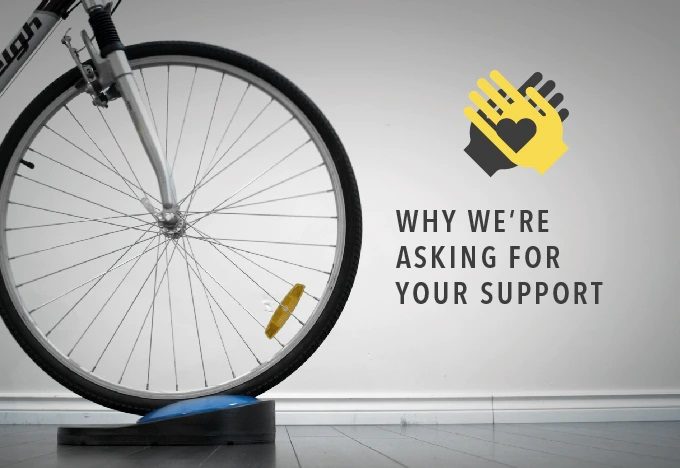Indoor cycling has really become something of a fitness phenomenon in recent years. Services such as Zwift and Peloton have achieved an almost mainstream awareness and have certainly elevated indoor biking from being what was a previously tedious affair into a fashionable, even desirable workout activity. This interest has also translated well to virtual reality fitness with Virzoom’s VZfit now well established, a growing community of avid Explorers clocking of thousands of virtual miles each week, and Holodia’s Holofit allowing you to cycle, as well as row or run through their own virtual environments.
Now a third party, Kinbona, is looking to launch its own VR biking system, Blync, with a Kickstarter Campaign running now through to September 10th. Interestingly where Virzoom and Holodia have looked to support stationary bikes, Kinbona is aiming to encourage cyclists to bring their road bikes indoors. You connect up your bike via a trainer (sold separately) attach Blync’s speed sensor to the rear wheel and then place the front wheel into the Blync path sensor controller. This allows you to steer your actual road bike using the handlebars, which is definitely a novelty in VR cycling currently.
Let’s investigate.
The video below demonstrates some very impressive graphics for virtual reality, especially the forest biking at the end.
Blync’s Mission Statement
Kinbona consists of a small team of engineers and designers led by Izuchukwu Okongwu. As he writes on his Kickstarter page, ‘The idea for Blync came to me when my wife bought her bike but could not ride it because of her busy work schedule and our two young kids. As I was looking for a solution, I got to experience VR for the first time.
I then asked, “What if I can make my wife feel like she is riding outside while she is at home using a VR system?” This is how I began developing Blync.
With my background in hardware and software systems design, together with a team of engineers and designers, we are committed to make Blync a reality with the highest quality possible. Thank you for your support!’

Pricing and How it Works
The early bird asking price is $74 (£58) but there are not many left at that price, the regular backing price is then $89 (£69).
Taken from their Kickstarter page ‘the Blync package contains the Path Sensor, the Speed sensor, and access to the App with all the environments that you can bike in. The Path Sensor is designed to support any wheel size of a bike. You just need to place your bike’s front wheel on the Path Sensor, strap the speed sensor at your back wheel’s hub, and you are done with the setup.
Your back wheel needs to be secured on a bike trainer. Bike trainers are commercial fitness equipment that securely mounts your bike for indoor biking. For more information on bike trainers, visit our website www.blync.bike
Blync works with a VR device as well as computers. If you don’t have a VR device, you can enjoy your virtual biking using a computer screen. We are working to support the most popular VR devices and will continually add support for more. For more info on VR devices visit our website www.blync.bike’


First Thoughts
Although virtual reality technology is still in a relatively nascent, developmental stage when it comes to virtual reality cycling the field is already fairly crowded. Kinbona’s Blync will need to offer some compelling features to differentiate itself from Virzoom’s VZfit and Holodia’s Holofit, both of which are already fairly well established.
From the details, we have so far Blync does seem to have some novel features, however. Firstly their target customer is actual road bike users, rather than VR gamers who own an indoor exercise bike. As their setup requires placing a front wheel into the path sensor it’s probably not even possible to connect this to a stationary bike so the market audience, at least currently is different.
I like the idea of being able to steer with your bike handlebars, having the front wheel mounted in the path sensor. This contrasts with Holofit’s on rails experience and Virzoom’s head tilt movement and could possibly allow for more freedom and control whilst feeling more stable and natural than Virzoom’s method.
The graphics of the more recent environments look very impressive, with jumps and off-road BMX style courses, which could prove to be quite thrilling in VR. Nausea might be a real concern there but I’d certainly be keen to try it.
Looking at the graphics of the later levels this would seem to be a PC VR experience but Kinbona says they will support all Oculus headsets as well as most Steam ones. I’m not at all convinced an Oculus Go can reproduce the graphics shown in the BMX forest track, and doubtful even the Quest could so I’m interested to know more about the engine.
There’s also a custom level builder allowing the user to create their own rides. If that is easy to use it could make for a fun combination of level design and racing around your own worlds, which could be further enhanced if users are able to share and download each other’s designed levels.
Interestingly I can’t see any mention of a monthly subscription cost, which would be unusual for this kind of service. A one-off cost for a use forever service would offer excellent value, but I’m not sure how they then plan to fund ongoing software development
I have lots of questions so have reached out to the developers for an interview as this is certainly a product I’m keen to know more about. Hopefully, we will have more information to follow, but in the meantime, if you have a road bike and would like to bring it into virtual reality rather than using a stationary bike this could be a very interesting option.
Check out their Kickstarter for full details.


